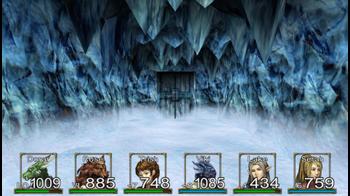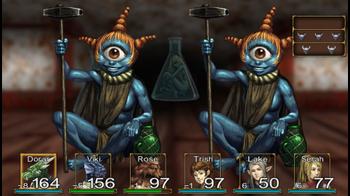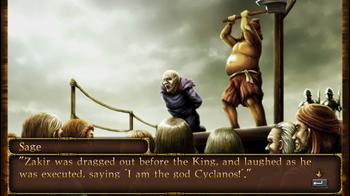
Elminage Gothic Review
Elminage Gothic is a first-person dungeon crawler, structured and styled very similarly to those of the Wizardry series. It is not a game for everyone, and it doesn’t try to portray itself otherwise. If you have been acquainted to the genre via recent titles like Etrian Odyssey or Demon Gaze, you might believe you know what to expect here. You’d be wrong on that account. This takes dungeon crawling to the next extreme. Get that graph paper ready.
Elminage Gothic is very old fashioned in many regards. It doesn’t have tutorials, and there is no real ‘warm-up’ period to speak of. You boot up the game and right away you are tasked to create a party and explore a cave. The game doesn’t take the time to explain anything to the player - not combat mechanics nor menu explanations. Right away, it’s clear that you shouldn’t expect gentle introductions to anything Elminage Gothic has to offer.
Players are given full control in how they build their party. There are a few pre-built characters to choose from, or you can build your own to use. From race and class to stats and abilities, it’s a very flexible and open system. Like most of the rest of the game, there’s nothing here to hold your hand through this process, and the only assistance given are some brief menu descriptions. You are given the tool-chest and only by trying things with it are you going to get familiar with what certain classes are capable of.
Characters are built in a fashion similar to the Dungeons & Dragons style, with points to allocate to stats like strength or intelligence. You can have six members in your party, with three in the front row and three in the back. Enemy groups have rows as well, and different abilities and weapon types are able to target different rows. As you might anticipate, it’s smart to put sturdy units up front and the less resilient units, such as mages, in the back. With many race and class options available, there are few restrictions in how you how you can approach creating your team.
Combat is probably the most straightforward component to the game. Enemies are encountered in groups and engaged in a round-based system. You select your party's actions, and then the turn-order is decided by each participant's agility stat. The goal, of course, is to keep your party alive and the deplete the HP of all enemy units. But this is easier said than done, as there are many tough creatures that will test your ability to do just that. This isn't your average RPG where random mob encounters are mostly there to easily push aside as you progress through the game. Instead, every battle has the chance to be tense, and every battle is likely to defeat you if you don't prepare properly. Random encounters can be just as dangerous as boss fights.
The battles aren't the only thing to keep in mind when you are forming your party, though. Many other abilities are needed to keep your characters healthy and your wallet full. Thieves, for instance, are very useful in opening chests to gain loot and gold, even though they aren’t much good in a fight. Alchemists can be used to upgrade the parameters of weapons and armor or to add elemental affinities. One of my most valuable characters was a Servant – an herbalist who could synthesize status curing items and use them instantly in combat on anybody in the party as soon as they were afflicted. For most of the game I didn’t have to worry about the multitude of various status effects because of that character’s ability, which opened up my healer unit to focus on other tasks such as HP replenishing or stat boosting.
After getting the hang of menu navigation and party creation, it’s time to get into the centerpiece of Elminage Gothic: exploring dungeons filled to the brim with demons and monsters. Navigating these mazes is best done with patience and persistence. This is the type of game that rewards deliberate and meticulous play styles. Go in recklessly and you will find the Game Over screen quickly. Battles will test your patience and dungeon traps will do their best to confound and frustrate you. Luckily, this difficulty is balanced by being able to save at any time, which is something I found myself doing very frequently.
The one design decision that is most problematic is how the game allows the player to view the map. As with most dungeon crawlers, it is extremely easy to get lost when you can’t reference your current location, especially in first-person. You can buy a map item which, of course, allows you to view the map of the current floor – but only once – and then the item disappears, acting as a consumable. With lots of dead ends and maze-like structures to be found, checking the map is something you’re going to want to do often.
This means you have to buy maps as you would potions, keeping a collection of them available at all times to use when you need to. As I progressed further and further into more and more complex dungeons, separating already tight inventory space to hold stacks of one-time use map items became more of a chore than an interesting limitation. Outside of anything else the game has to offer, this can easily be a deal-breaker. You can get around this by modifying the game files or looking up maps online.
The main storyline in Elminage Gothic is a very minimalistic one, which really only serves to open up more locations to explore. There are a good variety of dungeon ‘gimmicks’ to keep things fresh outside of different visual styles. There’s the token ice-sliding dungeon, some that go nuts with warp tiles, and even one that loves to warp you to identical looking rooms without any indication that you even moved at all.
The game also has quite a number of quest events to reward you for going out of your way to explore to the corners of the various dungeons. Many require conquering extra bosses or navigating to the most difficult-to-reach places. While totally optional, gaining more levels and equipment by completing these events is very beneficial. Elminage Gothic is challenging the whole way through, so anything to up your advantage is something you are going to want to do.
Elminage Gothic sets out to fulfill a very specific niche and succeeds at doing so. It’s not trying to appeal to a wide audience or to turn the genre on its head. If you are the type of person who relishes in challenging themselves, with the patience to crawl through hordes of relentless enemies, then you can’t do much better than this. At around 50 hours long, this is a task not quickly completed.


